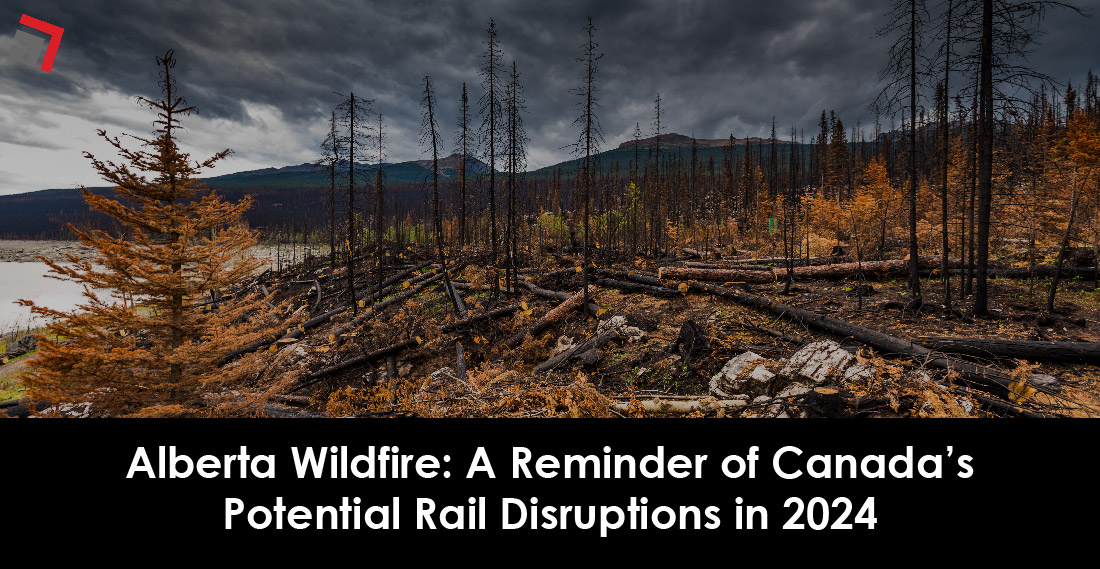Last week, wildfires ravaged a community in Western Canada, disrupting freight rail traffic in the process. Railway Canadian National has since resumed service prior to the weekend and, according to data from RailState, a rail network visibility provider, freight movement has since recovered to business-as-usual.
While conditions have returned to normal, the temporary stoppage was a serious issue. CN’s main line was shut down through Jasper, the Alberta town devastated by the wildfires, which choked intermodal freight moving to and from the seaports of Vancouver and Prince Rupert, the two largest trade centers on the Canadian West Coast. Last week’s service outage reduced the flow of traffic to Vancouver by 46 percent and to Prince Rupert by 42 percent, according to RailState. The disruption also had a notable impact on transit times for eastbound rail traffic (moving from the ports) due to congestion spawned by the number of trains held while the line was closed.
The wildfires have also curtailed passenger rail service, including VIA Rail’s decision to pause services between Vancouver and Edmonton until Aug. 5. Last week, the wildfires engulfed nearly half of Jasper, destroying much of the town’s infrastructure. Authorities have implemented evacuation orders for some 25,000 residents and tourists for an indefinite period of time. The blazes remain out of control in Jasper National Park.
What can be done amid freight rail, intermodal disruptions?
Freight rail is typically a safe and dependable mode to transport international intermodal freight. The other week, our crew at Commerce Express Inc. shared the service advantages of using freight rail to connect one’ s supply chain. However, in the harsh reality of logistics, things can go wrong and unimaginable events will rear their unflattering faces at the worst of times. Last week, whether they had exports destined to load at Prince Rupert or awaiting their container import that was handled by Vancouver, an unfortunate collective of U.S. international intermodal shippers felt the weighted costs in transit delays as wildfires, events outside of everyone’s control, ran amok across the forests of Alberta.
While this particular disruption has eased, the ongoing wildfires present a lingering risk to freight rail transits through Western Canada. The development comes as labor uncertainty over a potential nationwide rail strike also heats up. Should that occur, it wouldn’t just be any given stretch of line in the Canadian wilderness, but the totality of Canada’s freight rail network that would grind to a halt.
These issues aren’t intended to scare shippers from using rail to move their freight through Canada, but rather stress to them the importance of having alternatives in place. Canada’s railroad executives speculate a strike could happen in late August. While nothing is certain, it would be costly to assume that Canada’s rail movement will go undisturbed over the next several weeks.
For example, let’s say there’s a U.S. shipper based near Chicago whose container imports from Asia come through the Port of Vancouver. Their prevailing method is transferring the containers from the cargo ship onto railcars bound to one of Chicago’s several rail ramps. From there, it’s a brief trucking leg from the ramp to the importer’s door near Chicago. The shipper prefers this arrangement given the simplicity of the routing as well as the cost savings of choosing rail over long-haul truckload for a lengthy distance between Vancouver and Chicago.
But, what if there’s uncertainty with freight rail north of the border?
The first question that the “hypothetical, but in reality, pretty relatable” U.S. shipper should ask: what parts of an international shipment do I have control over? If the U.S. shipper has control over booking the ocean freight transit of their imports, the best way to avoid potential rail strife in Canada is by rerouting their freight from Canada’s West Coast to the U.S. West Coast instead. From there, their intermodal containers could move from the ports of Los Angeles, Oakland, or Seattle to Chicago.
But what if the U.S. shipper doesn’t control the ocean freight routing?
In the case that their overseas suppliers determine which port their inbound cargo will arrive at, U.S. shippers will have to be more creative with their options to avoid potential disturbances to Canada’s freight rail. Let’s keep using the example of the U.S. importer based near Chicago, while adding that their transportation decisions are limited to once the containers arrive in Vancouver. They have no control over the ocean transit. That said, let’s say their latest container arrives in Vancouver. In the week leading up to its arrival, unionized rail workers at Canada’s two Class I railroads have since gone on a nationwide strike. In this hypothetical scenario, congestion-related delays have hammered Canada’s freight rail movement.
The U.S. importer has two options to avoid the chaos. The first option is transloading their cargo and trucking it from the port to their door near Chicago. Of course, this option is startling to consider. This would be a long-haul truckload shipment of epic proportions, a journey of well-over 1,000 miles. It certainly would cost more than rail—oh wait, rail movement is constricted. Would this importer accept the inevitable, indeterminate, delays they would endure sending their freight on rail? It’s likely that they wouldn’t. While trucking is not a usual preference for shipments that cover distances of over 1,000 miles, the quick and disruption-free transit would bring peace of mind amid the chaos.
The second option involves both truck and rail. Like the first one, this second option begins with cargo being transloaded and trucked from Vancouver. However, instead of a direct, long-haul, trip to Chicago, the freight would be diverted to a rail ramp on the U.S. West Coast, like Seattle or Oakland. From there, it would be railed to a Chicago ramp. Keep in mind, while the rail leg of shipment would be cheaper than a Vancouver-Chicago truckload, the shipper will be paying more in total with the second option considering the addition of a transload and trucking from Vancouver to one of the U.S. West Coast ramps.
Of course, this is hypothetical. A freight rail strike in Canada hasn’t happened—at least, not yet.
If you happen to be a shipper who utilizes Canada’s ports and/or rail networks, do you have alternative options in place?




Recent Comments